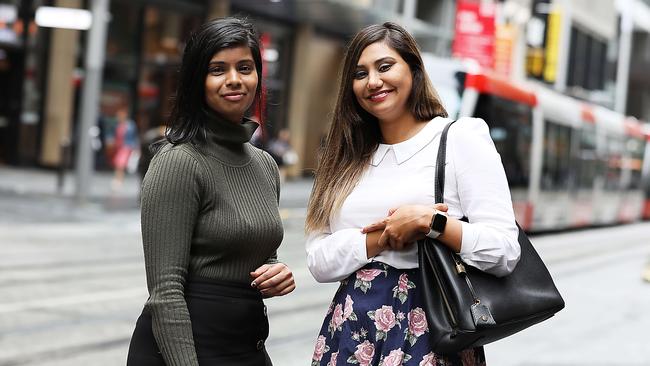Coronavirus: Little by little, our cities come back to life
Public transport data has revealed Australia’s CBDs remain half-empty despite the near eradication of the virus.

Sydney’s CBD hummed with activity on Monday after NSW Health repealed the state’s public order requiring employers to let employees work from home if they choose to, but public transport data reveals cities are still half empty despite the near eradication of the coronavirus.
As the pandemic swept across the country in March, companies had to hastily erect frameworks enabling their businesses to continue remotely, moving hordes of workers into home offices.
While Chhaya Chetty, 25, didn’t have an option to work from home, operating out of the office full-time since the pandemic struck, Rhea Sharma, 28, returned to the office after she started a new job in November, splitting her time between home and her office near Martin Place
“I live out west and I drive to (inner west suburb) Petersham so I don’t have to stay in the train for as long. That’s something I consider now — I have a freak-out if I don’t have a mask,” Ms Sharma told The Australian.
Both said they had noticed a marked increase in the number of people in the city over the past month. “It’s definitely got busier since the city was a dead valley in March,” Ms Chetty, a paralegal, told The Australian.
“I was in Barangaroo and it was like COVID-19 never happened,” lawyer Ms Sharma added.
While the coronavirus has been all but eradicated in Australia, data obtained by The Australian shows public transport usage during peak hours remains almost 50 per cent below the same period last year.
In NSW, usage in December remained 45 per cent below the same month in 2019, having marginally increased by 7 per cent since October.
It’s a similar story in Queensland, where afternoon peak CBD patronage in November remained 46 per cent below the previous year. And in Victoria, public transport usage was running at 45 per cent of usual levels, after falling to just 9 per cent.
“We expect public transport patronage to remain low while only 25 per cent of office workers are able to return to offices and people are away for Christmas and new year holidays,” a spokesman for the Victorian Department of Transport said.
The depressed levels of public transport use are despite 70 days of no community transmission in Queensland, 45 days in Victoria and 10 in NSW.
While public transport use can be partially attributed to company edicts not requiring employees to return to the office until next year, and people using alternative methods to get to work, a significant factor has been people preferring to work from home.
Research conducted by University of Sydney professor Marian Baird found the lockdown period had contributed to more employees wanting to work from home, but she described prophecies predicting the impending doom of office spaces and CBDs as a “bit of excitement”.
“It won’t be as radical a shift (to working from home) as we thought six months ago,” Professor Baird said.



To join the conversation, please log in. Don't have an account? Register
Join the conversation, you are commenting as Logout